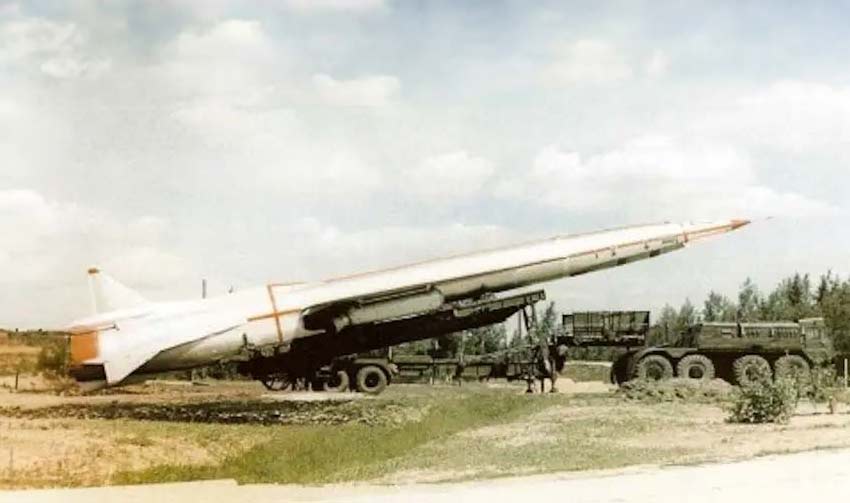The Tupolev Tu-123 Yastreb is a high-altitude, high-speed Soviet SIGINT reconnaissance drone developed during the Cold War.
In Brief
The Tupolev Tu-123 Yastreb was a Soviet long-range, jet-powered unmanned aerial vehicle designed primarily for strategic reconnaissance missions. Introduced in the 1960s, it was capable of high-altitude, supersonic flight, equipped with cameras and SIGINT equipment to gather intelligence deep behind enemy lines. The drone was launched using a solid rocket booster and recovered by parachute. Although it was a disposable aircraft, intended for single-use missions, it provided invaluable intelligence data. With its impressive speed and altitude capabilities, the Tu-123 was a significant asset in the Soviet Union’s military reconnaissance operations, offering a glimpse into remote enemy activities without risking crew lives.
The Tupolev Tu-123 Yastreb emerged as a strategic asset in the Soviet military’s reconnaissance fleet, reflecting the technological advancements and strategic demands of its time.
History of the Development of the Tupolev Tu-123 (Yastreb)
In the context of the Cold War’s escalating espionage and intelligence activities, the Soviet Union recognized the urgent need for a sophisticated reconnaissance platform to conduct over-the-horizon surveillance. This requirement led to the development of the Tupolev Tu-123 Yastreb, initiated to surpass the limitations of existing reconnaissance aircraft and unmanned aerial vehicles (UAVs).
The program, launched by the Tupolev design bureau, aimed to create an unmanned aircraft capable of high-speed, high-altitude intelligence gathering, with a focus on signal intelligence (SIGINT) and photographic reconnaissance. The Tu-123 was designed to penetrate deep into enemy territory, capturing vital intelligence while remaining beyond the reach of most anti-aircraft systems.
The drone first flew in the early 1960s, marking a significant milestone in unmanned aviation. It was a period when the importance of aerial reconnaissance was paramount, given the lack of satellite technology robustness available today. The NATO reporting name for this UAV is not widely recognized, reflecting the secrecy that typically surrounded Soviet military projects.
Design of the Tupolev Tu-123 (Yastreb)
The Tu-123 Yastreb was engineered with a focus on high-speed, high-altitude flight to evade enemy defenses. Its design featured a slender fuselage, swept wings, and a distinctive vertical stabilizer, optimized for supersonic speeds. The aircraft was powered by a Dobrynin RD-36-41 turbojet engine, supplemented by a solid-fuel rocket booster for launch, enabling it to reach unprecedented speeds and altitudes for reconnaissance missions.
The UAV was equipped with sophisticated SIGINT apparatus and high-resolution cameras, encapsulated in a re-entry capsule that could be ejected over friendly territory and retrieved post-mission. The Yastreb’s design also incorporated a unique recovery system involving a parachute, allowing the drone to be recovered, potentially refurbished, and reused.
However, the advanced capabilities came with significant drawbacks, including the high cost of production, complexity of operation, and the single-use nature of the aircraft, which often led to the loss of valuable equipment.

Performance of the Tupolev Tu-123 (Yastreb)
The Tu-123 Yastreb was distinguished by its exceptional performance characteristics. It was capable of reaching speeds exceeding Mach 2.3, with an operational ceiling above 20,000 meters (65,600 feet), and a maximum range of approximately 3,200 kilometers (1,988 miles). This performance enabled the Yastreb to conduct swift, deep penetration reconnaissance missions, outpacing many interceptor aircraft and surface-to-air missiles of its time.
Comparatively, the Tu-123 outperformed many contemporary reconnaissance platforms, offering greater speed and altitude than manned aircraft like the U-2, and more range and payload capacity than other UAVs of the era. Its ability to gather intelligence from well within enemy territory provided the Soviet military with significant strategic advantages.
Variants of the Tupolev Tu-123 (Yastreb)
The Tu-123 Yastreb was primarily built in a single configuration due to its specific mission profile and the technological constraints of the time. However, there were proposed variants and developmental offshoots intended to enhance its capabilities, such as improved engine variants or those equipped with advanced reconnaissance sensors. Details on these variants remain scarce, reflecting the secretive nature of Soviet military projects.
Military Use and Combat of the Tupolev Tu-123 (Yastreb)
The Tu-123 Yastreb was extensively used by the Soviet Union for high-altitude, high-speed reconnaissance missions, mainly along the borders of NATO countries and in strategic areas during the Cold War. Its missions were highly classified, focusing on gathering SIGINT and photographic intelligence crucial for Soviet strategic and tactical planning.
While there are no publicly documented instances of the Tu-123 being used in direct combat, its intelligence-gathering missions were critical in providing the Soviet Union with a strategic advantage, enhancing their awareness of enemy capabilities, installations, and potential vulnerabilities. The aircraft’s operational history remains largely classified, with specifics of its missions guarded closely by the Russian military to this day.
The Tupolev Tu-123 Yastreb was a remarkable embodiment of Cold War-era innovation in aerial reconnaissance. As one of the early forerunners in high-speed, high-altitude UAV technology, it set significant precedents for the future of unmanned intelligence-gathering platforms. Despite its eventual obsolescence and replacement by more advanced systems, the Yastreb’s contributions to aerial reconnaissance and its role in enhancing the Soviet Union’s strategic capabilities during a critical period of global tension remain noteworthy in the annals of military aviation history.
Back to the Drones, UAVs, UCAVs page